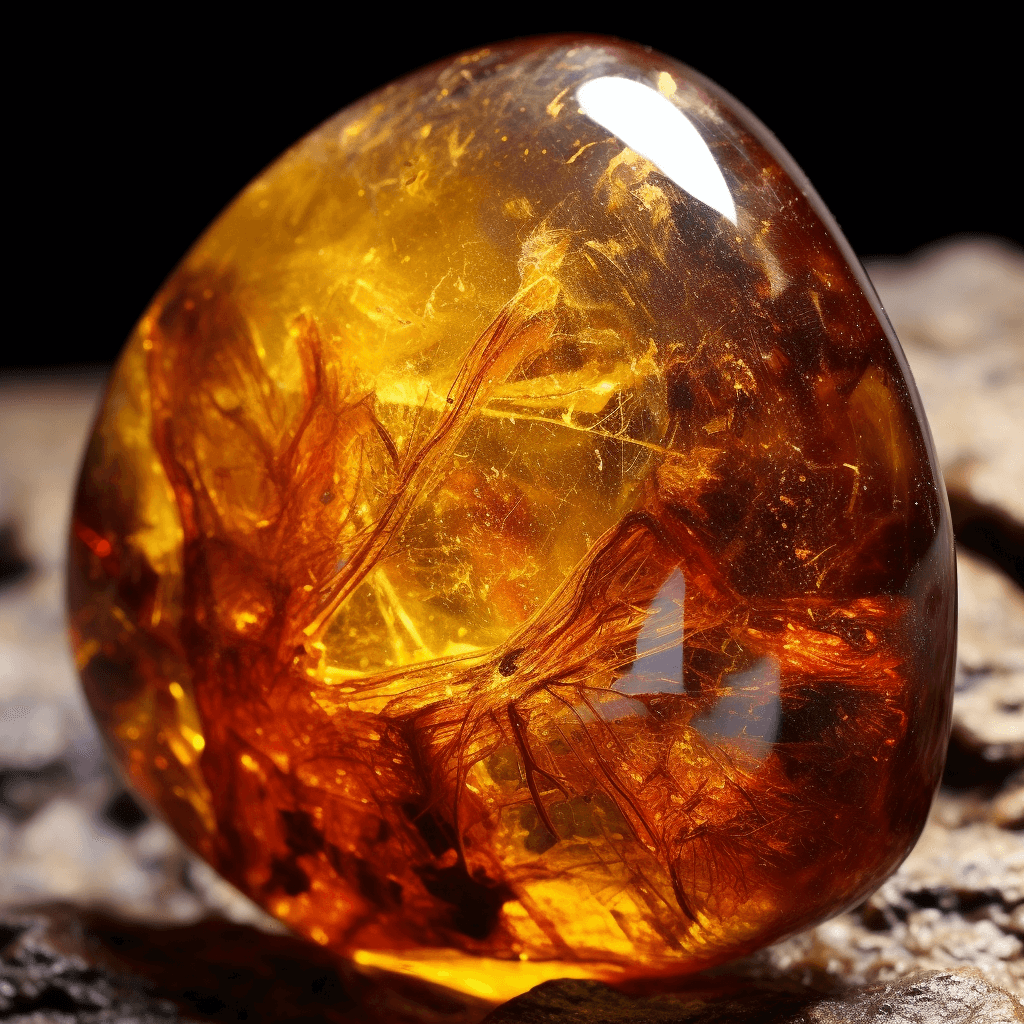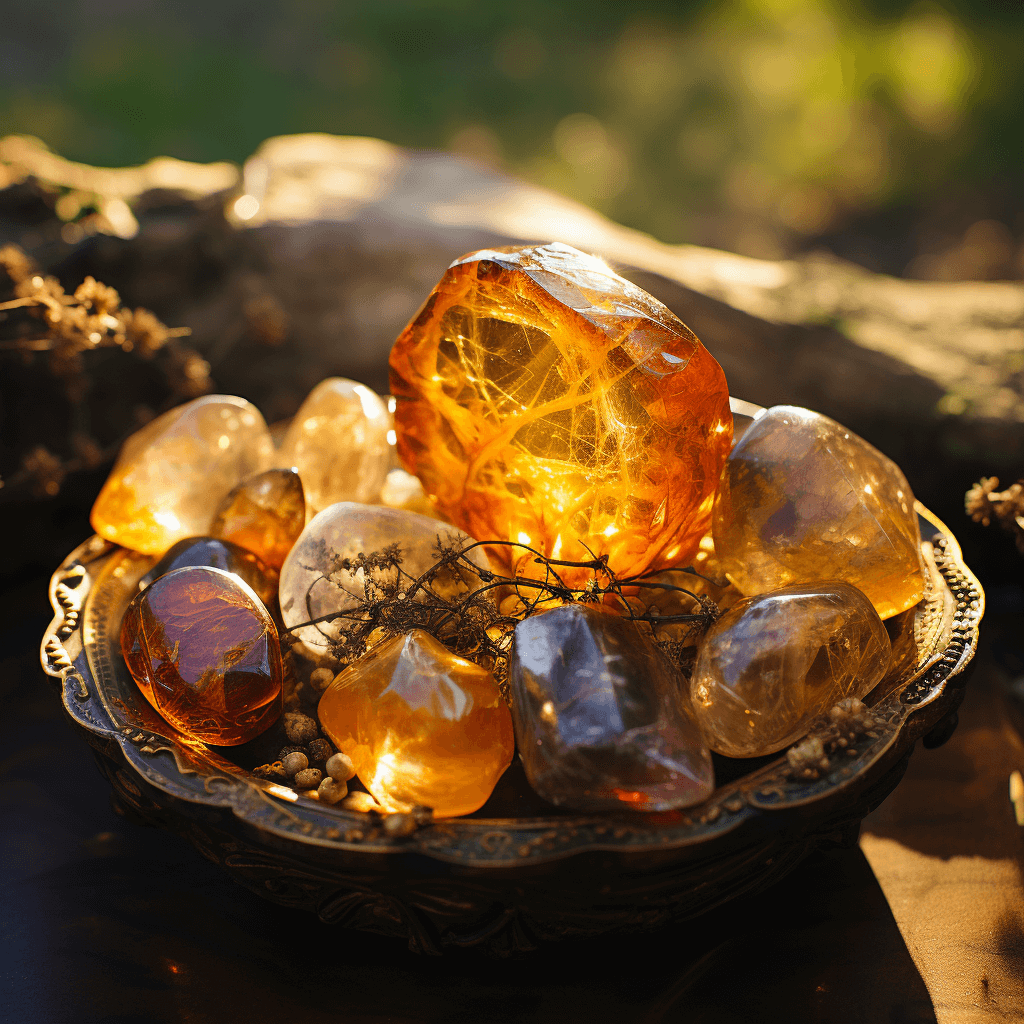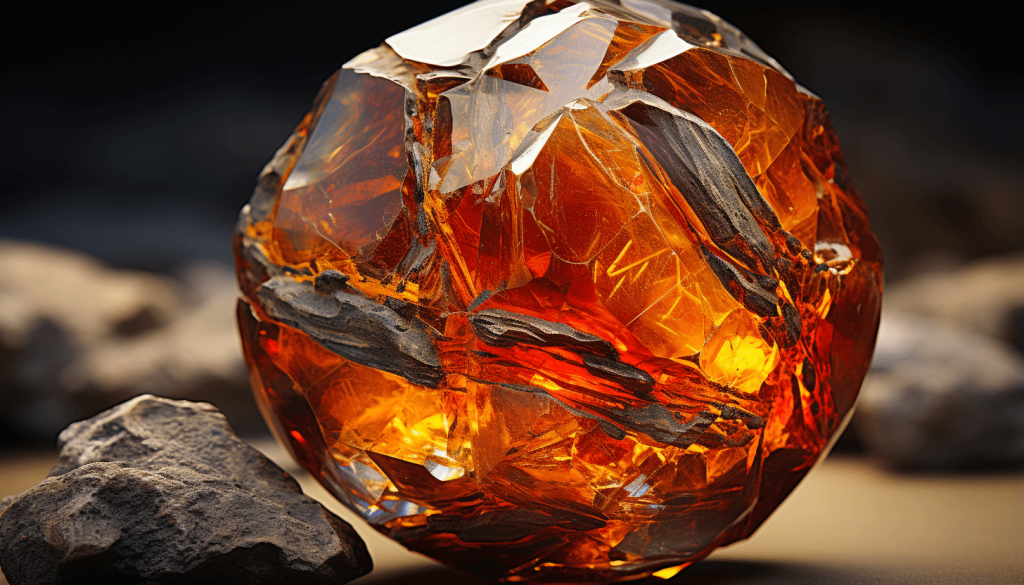Introduction to Amber: A Glimpse into Nature’s Time Capsule
Amber, often referred to as “Nature’s Time Capsule,” is a fascinating organic gemstone formed from the fossilized resin of ancient trees. Its warm golden hues encapsulate a world from millions of years ago, often preserving prehistoric flora and fauna, offering a direct window into the bygone eras of our planet.
Unlike most gemstones that are mined from the earth, amber is unique in its organic origin. Over millions of years, the sticky resin from ancient trees hardened and transformed into the gem we recognize today. This process, known as polymerization, turns the resin from a soft, sticky substance into a hard, translucent gem.
Amber’s allure isn’t just in its beauty but also in its history. The inclusions found within amber, ranging from tiny air bubbles to trapped insects and plants, tell stories of ecosystems long vanished. These inclusions provide invaluable insights for scientists, especially paleontologists, about the environment and climate of ancient Earth.
Formation and Geological Origins of Amber: A Journey from Resin to Gemstone
Amber’s formation is a testament to the intricate processes of nature. Beginning as tree resin, this organic substance undergoes a series of transformations over millions of years to become the captivating gemstone we admire today.
| Property | Description |
|---|---|
| Origin | Amber originates from the fossilized resin of ancient trees, primarily conifers and angiosperms. |
| Age | Most amber pieces are between 15 to 300 million years old, with some rare specimens dating back even further. |
| Process of Formation | Over time, the resin undergoes polymerization, where volatile compounds evaporate, and the resin hardens. Subsequent heat and pressure from overlying sediment further transform the resin into amber. |
| Color Variations | While golden-yellow is the most common, amber can range from whitish to pale lemon, deep orange, brown, and even green or blue. The color depends on factors like tree source, soil type, and age. |
| Inclusions | Amber often contains inclusions such as insects, spiders, plant material, and even microorganisms. These inclusions are trapped during the resin’s sticky phase and get preserved as the resin fossilizes. |
| Transparency | Amber’s transparency varies. It can be completely clear or opaque, depending on the presence of air bubbles or other inclusions. |
| Hardness | On the Mohs scale, amber ranks between 2 to 2.5, making it softer than most gemstones. It’s lightweight and can float in saltwater. |
| Geographical Locations | Significant amber deposits are found in the Baltic region, the Dominican Republic, Myanmar, Mexico, and Russia, among other locations. |
Understanding the geological properties of amber provides a deeper appreciation for this gemstone, which encapsulates the beauty and history of our planet in its golden depths.
The Fascinating Colors and Varieties of Amber

Amber, with its organic origins, showcases a spectrum of colors, each telling a unique story of its formation and the environment from which it came. The color of amber can be influenced by various factors, including the type of tree it originated from, the conditions of the surrounding environment, and the age of the amber itself.
| Color | Description |
|---|---|
| Golden-Yellow | The most common shade, this classic amber hue is often associated with the Baltic region. |
| Orange | A deeper, richer shade than the classic golden-yellow, often found in Dominican amber. |
| Red or “Cherry” | While rare, this shade can be found in some Baltic amber pieces. Prolonged exposure to sunlight can also turn amber reddish. |
| Green | Green amber is primarily found in the Dominican Republic and is often a result of plant-based inclusions or the presence of certain minerals. |
| Blue | One of the rarest shades, blue amber is mostly found in the Dominican Republic and exhibits a mesmerizing blue sheen under certain lighting conditions. |
| White or “Bone” | Characterized by a milky, cloudy appearance, this variety contains numerous tiny air bubbles. |
| Black | Often containing many inclusions, black amber is dense and can be found in several locations, including the Baltic region. |
| Brown | A common shade, especially in the Baltic region, ranging from light to dark brown. |
These diverse colors and varieties make amber a versatile gemstone, suitable for various jewelry designs and aesthetic preferences.
Historical and Cultural Significance of Amber: From the Baltic to the Tropics
Amber’s allure transcends its physical beauty. For millennia, various cultures have revered this gemstone, attributing to it not only ornamental value but also spiritual and medicinal significance. Its presence in archaeological sites and ancient texts underscores its importance in human history.
In the Baltic region, amber, often referred to as the “Gold of the North,” played a pivotal role in trade. The famous “Amber Road” was a historic trade route that facilitated the movement of amber from the Baltic Sea to parts of Europe, Asia, and even North Africa. Baltic amber became a highly sought-after commodity, often used in jewelry, amulets, and even for barter.
Moving to the tropics, in regions like the Dominican Republic, amber was considered a sacred stone by the indigenous Taino people. They believed it had healing properties and used it in rituals and as adornments.
In ancient China, amber was a symbol of courage and bravery. It was often carved into intricate designs and worn by nobility. Similarly, in ancient Rome, amber was a symbol of status and wealth, with Roman women adorning themselves with amber jewelry to showcase their affluence.
Amber was often used in ancient perfumes. When heated, it releases a pleasant pine-like fragrance, which was incorporated into early aromatic concoctions.
From being a symbol of prestige to a medium of trade, amber’s historical and cultural significance is as multifaceted as the gemstone itself.
Metaphysical and Healing Properties of Amber: Harnessing Sun and Earth Energies
Amber, often described as solidified sunlight, is believed to possess potent metaphysical properties. Its warm, golden hues are reminiscent of the sun, and many cultures have associated amber with life-giving solar energies. Beyond its visual appeal, amber has been used for centuries in various traditions for its perceived healing and spiritual benefits.
Emotional and Mental Healing
Amber is thought to be a powerful cleanser of the mind and spirit. It’s believed to help alleviate stress, anxiety, and depressive feelings, replacing them with positivity and clarity. Its warm energy can inspire spontaneity, creativity, and a zest for life.
Physical Healing
Historically, amber was used in folk medicine for its purported anti-inflammatory properties. It was believed to ease pain, especially in the neck and head region. Some also wore amber necklaces hoping to alleviate symptoms of teething in infants or to boost the immune system.
Spiritual Growth and Protection
Amber’s connection to the earth and sun makes it a grounding stone for spiritual energies. It’s said to help in aligning the physical and ethereal bodies, enhancing meditation, and promoting a deeper connection to nature. Additionally, amber has been used as a protective talisman, believed to shield its wearer from negative energies and harm.
Chakra Healing
Amber is often associated with the Solar Plexus and Sacral Chakras. Its energies can help in balancing these chakras, promoting confidence, creativity, and personal power.
While the healing properties of amber are deeply rooted in tradition and folklore, many individuals continue to be drawn to its energies, incorporating it into modern holistic practices.
Amber in Astrology and Zodiac Connections & Birthstone
Amber’s ancient allure extends to the realm of astrology and zodiac symbolism. Its warm, radiant energy aligns with certain astrological signs, and its significance as a birthstone further cements its place in celestial lore.

Zodiac Connections
Amber is closely associated with Leo and Aquarius. Leos, ruled by the sun, resonate with amber’s sunny and vibrant energy, which can amplify their natural charisma, warmth, and leadership qualities. Aquarians, on the other hand, can benefit from amber’s grounding properties, helping them balance their innovative yet sometimes erratic energies.
Birthstone Significance
While not a traditional birthstone for any specific month, amber is often linked to those born in the sun sign of Leo, which spans from July 23 to August 22. Its sunny disposition complements the fiery and passionate nature of Leos, potentially enhancing their vitality and zest for life.
Amber is also considered an anniversary gemstone, specifically for the 34th wedding anniversary. Gifting amber on this occasion symbolizes the enduring warmth and glow of a relationship that has stood the test of time.
Whether connected to zodiac signs or significant life milestones, amber’s celestial connections highlight its timeless appeal and spiritual significance across cultures and ages.
Practical and Everyday Uses of Amber: Beyond Jewelry and Adornment
While amber is widely recognized for its beauty and use in jewelry, its applications extend far beyond adornment. Its unique properties and historical significance have led to a range of practical uses in various cultures and industries.
Medicinal Applications
In ancient times, powdered amber was used in traditional medicines, especially in Europe and Asia. It was believed to have healing properties and was used as a remedy for a range of ailments, from asthma to rheumatic pain.
Perfumery
Amber’s resinous and earthy scent has made it a sought-after ingredient in perfumes. When heated, amber releases a pleasant, pine-like fragrance. The essence, known as ambergris, has been used in high-end fragrances to add depth and warmth.
Art and Craft
Amber’s ability to preserve inclusions has made it a favorite among artisans. Intricately carved amber pieces, showcasing trapped flora and fauna, are considered masterpieces and are highly valued in art circles.
Scientific Research
The inclusions in amber, especially ancient insects and plants, offer a treasure trove of information for scientists. Paleontologists, in particular, value amber for the insights it provides into prehistoric ecosystems and evolution.
Industrial Uses
Amber’s natural resin properties have been explored for use in varnishes and certain types of lacquers. Its adhesive qualities were historically utilized in some regions before the advent of modern synthetic alternatives.
From its role in ancient remedies to its significance in modern science, amber’s versatility and unique properties ensure its relevance in various spheres of human endeavor, transcending its primary role as a gemstone.
Caring, Authenticating, and Distinguishing Genuine Amber from Imitations: Tips and Tricks for Enthusiasts
As with any precious gemstone, ensuring the authenticity and proper care of amber is crucial for both collectors and casual enthusiasts. Given its organic nature and the rise of imitations in the market, understanding how to distinguish genuine amber and maintain its beauty is essential.
Caring for Amber
Storage: Store amber pieces separately to avoid scratches. A soft cloth bag or a padded jewelry box is ideal.
Cleaning: Use lukewarm water and a soft cloth to clean amber. Avoid harsh chemicals or ultrasonic cleaners.
Protection: Amber is soft and can be easily scratched. It’s best to remove amber jewelry during physical activities and avoid direct sunlight or extreme temperatures.
Authenticating and Distinguishing Genuine Amber
Float Test: Genuine amber is lightweight. In a solution of saltwater (2 parts water to 1 part salt), real amber will typically float, while most fakes will sink.
Electrostatic Test: Rubbing amber will produce static electricity, attracting small paper pieces or hair. Most imitations won’t have this property.
Heat Test: Genuine amber has a distinct pine-like scent when heated, while imitations may produce a plastic smell. However, this test can damage the specimen, so it’s best used on small or less valuable pieces.
Visual Inspection: Genuine amber often contains tiny imperfections or inclusions. Uniformity in color and too-perfect specimens might indicate imitation.
While these tips can guide enthusiasts, consulting with a gemologist or an amber expert is the most reliable way to confirm authenticity, especially for significant purchases or investments.
The Allure of Amber Inclusions: Preserved History in Every Gem

One of the most captivating aspects of amber is its ability to preserve history. The inclusions within amber, whether they be tiny air bubbles, plant fragments, or ancient creatures, offer a direct window into bygone eras, making each piece a unique snapshot of prehistoric life.
Types of Inclusions
Flora: Fragments of ancient plants, such as leaves, seeds, or spores, are commonly found in amber. These remnants provide insights into the vegetation of prehistoric landscapes.
Fauna: From spiders and ants to beetles and even larger creatures like lizards, amber has preserved a diverse range of animals. These inclusions are invaluable for understanding the evolution and ecology of ancient ecosystems.
Microorganisms: On a microscopic level, amber can contain fungi, bacteria, and protozoa, offering a glimpse into the microbial world of the past.
Scientific Significance
Amber inclusions are not just curiosities; they are scientific treasures. They provide direct evidence of species that might not be found in the fossil record elsewhere. For paleontologists and biologists, these inclusions can answer questions about species evolution, behavior, and ancient environmental conditions.
Artistic and Monetary Value
From an aesthetic perspective, amber inclusions add to the gem’s uniqueness and beauty. Each inclusion tells a story, making the amber piece a conversation starter. This historical and artistic significance often translates to higher monetary value, especially for specimens with rare or well-preserved inclusions.
Amber’s ability to encapsulate history sets it apart from other gemstones. Each piece, with its inclusions, serves as a tangible connection to the ancient world, making amber a gem of both beauty and knowledge.
Comparing Amber with Similar Resinous Gemstones
Amber is not the only gemstone formed from organic resin. Several other resins undergo processes similar to amber’s formation, resulting in gemstones that can sometimes be mistaken for amber due to their similar appearance and properties. Understanding the differences between these gemstones can help enthusiasts and collectors make informed decisions.
| Gemstone | Origin | Appearance | Notable Properties |
|---|---|---|---|
| Amber | Fossilized tree resin | Golden-yellow to reddish-brown, can also be green or blue | Lightweight, often contains inclusions, warm to touch |
| Copal | Younger tree resin, not fully fossilized | Similar to amber but often clearer | Softer than amber, can be sticky, melts at a lower temperature |
| Jet | Decayed wood under extreme pressure | Black and can be polished to a high shine | Lightweight, warm to touch, can leave a brown streak on unglazed porcelain |
| Resinite | Fossilized resin from coal seams | Varies from yellow to brown | Older than amber, often found in coal mines |
While amber is the most renowned among resinous gemstones, each of these gems has its unique charm and history. Recognizing their differences ensures a deeper appreciation of nature’s ability to create beauty over time.
Environmental and Ethical Considerations: Responsible Amber Sourcing
As the demand for amber grows, so does the need for responsible sourcing. The extraction and trade of amber have environmental and social implications that consumers, traders, and artisans should be aware of. Ensuring that amber is sourced ethically and sustainably is crucial for the preservation of ecosystems and the well-being of communities involved in its trade.
Environmental Impact
Mining Practices: Unregulated or illegal amber mining can lead to deforestation, habitat destruction, and soil erosion. Such practices can disrupt local ecosystems and threaten biodiversity.
Rehabilitation: Post-mining, the land often requires rehabilitation to restore its ecological balance. Without proper restoration, mined areas can remain barren and unproductive for years.
Social and Ethical Concerns
Local Communities: In many regions, amber mining is a significant source of income for local communities. However, without fair trade practices, these communities might not receive adequate compensation for their labor and resources.
Child Labor: In some areas, children are involved in amber mining, often working in hazardous conditions. Ethical sourcing ensures that child labor is not part of the supply chain.
Certifications and traceability initiatives are emerging in the amber industry. These efforts aim to provide consumers with assurance that their amber products are sourced responsibly, without harming the environment or exploiting workers.
As consumers become more conscious of the origins of their purchases, the amber industry, like many others, is facing a call for transparency and ethical practices. By supporting responsible sourcing, consumers can enjoy the beauty of amber while ensuring its legacy is preserved for future generations.
Frequently Asked Questions
What is the primary difference between amber and copal?
Amber is fossilized tree resin that is millions of years old, while copal is younger tree resin that hasn’t fully fossilized. Copal is softer, can sometimes be sticky, and melts at a lower temperature compared to amber.
How can I test the authenticity of my amber piece at home?
One common method is the saltwater float test. Genuine amber is lightweight and will typically float in a solution of saltwater (2 parts water to 1 part salt), while most imitations will sink. However, it’s always best to consult with an expert for definitive authentication.
Is amber always yellow or golden in color?
No, while golden-yellow is a common shade, amber can come in a range of colors, including orange, red, green, blue, white, and even black. The color can be influenced by factors like the type of tree it originated from, the conditions of the surrounding environment, and the age of the amber.
Why is Baltic amber highly valued?
Baltic amber, often referred to as the “Gold of the North,” is renowned for its quality, age, and the rich history associated with the Baltic region. It has been traded and used for various purposes for thousands of years, adding to its significance and value.
Can amber melt?
Yes, amber can melt when exposed to high temperatures. It has a relatively low melting point compared to other gemstones. When heated, it releases a pine-like fragrance, which has been used in perfumery.

